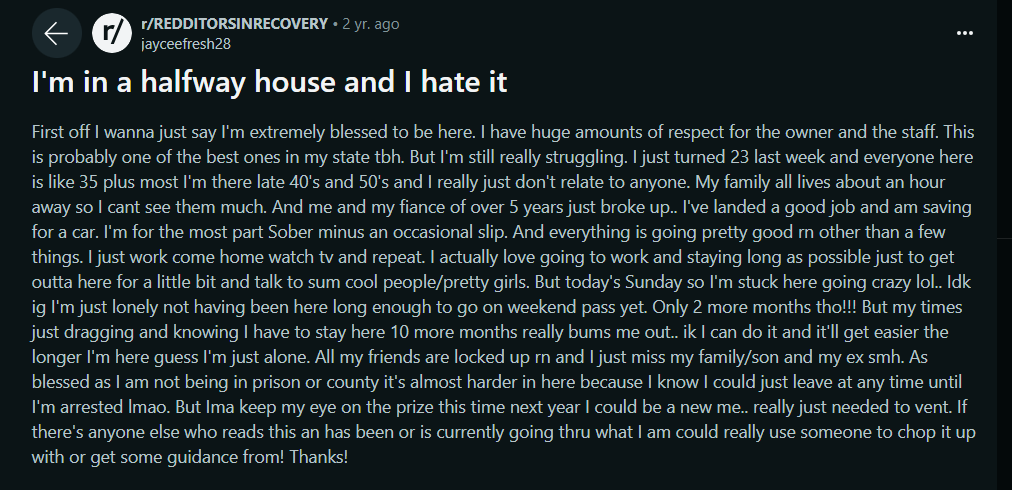A halfway house is a temporary home for people who need support to rejoin society. Orange County Drug & Alcohol Rehab Center offers one of the best drug rehabs in Orange County, CA. We treat diverse conditions and guide patients on their journey to sobriety. Halfway homes help people move from full-time care to living on their own. They offer a safe and structured place to live while getting support. Halfway houses provide supervision, social services, and guidance. This helps residents stay sober and rebuild their lives.

New You Sober Living in Oakland says halfway houses have a 61% success rate. Some programs have up to 93% success. Success means positive behavior, stable actions, keeping a job, and being financially independent. Oxford Academic's study also mentioned that people in halfway houses are less likely to re-offend. Those who go directly from prison to freedom have higher re-offending rates. Halfway houses provide structured environments. They offer support and accountability. This reduces the chances of relapse and re-arrest.

This guy on Reddit shares his experience living in a halfway house. At 23 years old, he finds it hard and even says that he hates it, although he feels blessed to be there.
The function of a halfway house extends beyond providing shelter. Halfway houses help residents learn life skills and take care of themselves. To live there, you must be sober or released from an institution. Residents must follow house rules. These rules often include curfews, job seeking, and community service. The rules create a safe and stable place that supports recovery and prevents relapse.
What are the Types of Halfway Houses?
Halfway houses come in different types. They can be categorized based on the residents they serve:
- Recovery Residences: Specifically for individuals overcoming addiction.
- Reintegration Housing: For former inmates transitioning back into the community.
Residents in halfway houses must follow certain rules. They need to stay sober, attend house meetings, and sometimes do chores. The level of support and structure varies. It depends on the residents' needs.
What is the Role of Halfway Houses in Addiction Recovery?
Halfway houses are crucial for people in the final stages of addiction recovery. They help transition from treatment to independent living. These homes blend treatment principles into daily life and offer needed support.
Treatment Integration
In halfway houses, residents continue to benefit from treatment integration. This means that skills from addiction treatments, like therapy and counseling, are used daily. Halfway houses typically require:
- Abstinence from substance use, ensuring a sober environment conducive to recovery.
- Participation in group meetings which may include 12-step programs or other support groups.
- Adhering to house rules that enforce the structure necessary for sustained sobriety.
Support Systems
The support systems within halfway houses are twofold: staff supervision and peer support. Residents receive ongoing support that can include:
- Regular meetings with counselors for continued addiction therapy.
- Random drug and alcohol testing to maintain accountability among residents.
- Residents interact with others who have similar recovery experiences, creating support.
Halfway House vs. Sober Living
While both halfway houses and sober living homes aim to support individuals in recovery, there are differences:
Halfway Houses often have a limit on how long residents can stay. They may be linked to government agencies or addiction treatment programs.
Sober Living Homes are usually more relaxed and offer a long-term stay. They provide a structured, sober environment without a set end date. Both types serve as crucial stepping stones towards independence for those overcoming addiction
What is it Like Living in a Halfway House?
Jessica Kent’s Real Life Experience Living in a Halfway House

Jessica Kent was jailed in Arkansas for drug and gun charges and gave birth in prison. After release, she stayed in a halfway house far from family. She faced unemployment, high rent, and strict rules. She struggled with personal hardships. She lacked proper clothing and relied on others for essentials.
Jessica’s Life Inside the Halfway House
Living in a halfway house was a unique part of Jessica's journey. She faced challenges but also had small victories. She shared the space with other women in recovery, learning to live with them. Everyone followed strict rules, like attending daily NA or AA meetings, staying sober, and helping with chores. Jessica was the house president. Her job was to enforce rules, such as curfews and monitoring substance abuse. It was hard for her to assert herself because she was empathetic. Enforcing rules was challenging due to the different needs of the residents.
The atmosphere was tense, with some residents facing expulsion for relapse. The fear of returning to prison was real. Despite this, Jessica stayed committed to her sobriety and remained resilient. The community in the house helped her stay hopeful.
Gradually, Jessica found a routine. Daily meetings reinforced her commitment to sobriety. The camaraderie with other residents helped her avoid isolation. Her hard work paid off, and she began to see a path forward. Life in the halfway house was tough, but it was a crucial step to stability, self-reliance, and recovery.
Jessica’s Life Today
Jessica has transformed their life, finding stability and a supportive community. She stresses staying focused, keeping a simple routine, and avoiding negativity. She believes in success after prison, despite struggles, and urges others to believe in themselves. Jessica now encourages others. She recommends watching Life After Lockup, as it shows reentry and reduces stigma.
What are the Services and Programs of Halfway Houses?
Halfway houses offer special services to help residents become independent and sober. These include emotional support, skill-building, and practical aid. The goal is to support recovery and reintegration into society.
Counseling Services
Residents at halfway houses have access to counseling services provided by trained professionals. It is a crucial component of the recovery process, focusing on:
- Individual Counseling: One-on-one sessions that address personal challenges and mental health issues.
- Group Therapy: Support groups provide peer support. Examples include Alcoholics Anonymous (AA) and Narcotics Anonymous (NA). In them, members share their experiences.
Educational and Job Assistance
These programs are fundamental services. They help residents find jobs and independence. These programs include:
- Life Skills Training: Lessons in basic finance, hygiene, time management, and other daily skills.
- Job Training: Vocational training and employment preparation services.
- Educational Programs: Opportunities to complete or advance educational qualifications.
Healthcare and Therapy
Healthcare services and therapy programs are vital. They are important for the health and well-being of residents. Core to this domain are:
- Healthcare Services: Regular health check-ups and management of medical conditions.
- Mental Health Services: Treatments and support systems for various mental health needs.
- 12-Step Meetings: Structured support aimed at reinforcing sobriety through proven methodologies.
What are the Common Challenges of Halfway Houses?
Halfway houses help with recovery but also bring challenges for residents and staff. They need to manage relapses, tackle mental health issues, and deal with legal and privacy concerns.
Handling Relapse
Residents in halfway houses are typically required to remain sober. Despite this, relapse is a reality that must be both prevented and properly managed. To mitigate this risk, halfway houses often enforce:
- Random drug and/or alcohol testing: To ensure compliance with sobriety.
- ero-tolerance policies: Outlines the consequences of relapse. These consequences may include removal from the facility.
Legal and Privacy Concerns
Halfway houses often house individuals involved with the criminal justice system. They must therefore navigate:
- Legal obligations: Adhering to court orders and ensuring compliance with legal requirements.
- Privacy issues: Privacy is important. Residents have rights to it. But, they must be balanced with the need for supervision and community safety.
What is the Phase Four of the Intensive Outpatient Counseling Program at Orange County Drug & Alcohol Rehab Center?
Phase Four of our drug treatment program entails an intensive outpatient counseling program. As you begin to feel more like yourself again without substances, you’ll need to go through an outpatient program. Especially one that will help you get to the root of your addiction.
To learn more about our outpatient counseling program and how you or a loved one can become admitted into our drug treatment program, reach out to us.
What To Expect With Phase Four Of Our Drug Treatment Program
In Phase Four, you will begin to learn how you can live a life without drugs and alcohol. While the previous phases detailed detoxing your body and your mind from substances, in Phase Four, we’ll help you with those mental hurdles. Add those unresolved emotions that you might be struggling to overcome.
We’ll help you break free of those constraints as well as help you achieve a better awareness of your own happiness with your life. When you enter Phase Four, you’ll work with a chemical dependency counselor who can help you learn how to live in the present.
How Does Phase Four Work?
Phase Four is the final step of our drug treatment program. As we enter Phase Four, you’ll start a unique form of therapy. One that will help you handle any type of mental state you might find yourself in whether it’s an easy or a hard day.
Our philosophy at Orange County Drug & Alcohol Rehab Center is based on drug and alcohol counseling needs to dive into an individual’s past. This is to fully understand what has drawn them to drugs in the first place. The negative emotions that someone might exhibit is what drives a person to want to become happier with substances. We’ll help you look toward a future that is healthier and happy with the help of a trained professional.
Why You Should Select Orange County Drug & Alcohol Rehab Center
Located in California, Orange County Drug & Alcohol Rehab Center is a premier facility dedicated to guiding you towards long-term recovery. As a family-owned center, we pride ourselves on offering a unique rehabilitation experience. We address both physical and mental addiction. Our four-phase drug treatment program is designed to help you achieve a healthier and happier life free from substances.
Why Choose Us:
- Family Owned - We offer a personal touch and a compassionate approach to your recovery journey.
- PhD Level Clinical Director - Our program is overseen by an expert with a doctoral level of expertise.
- Masters Level Therapists Specialized in PTSD and Trauma - Our therapists are specialized in treating PTSD and trauma. This ensures comprehensive care.
- State Licensed and Joint Commission Accredited - We meet the highest standards of care and safety, giving you peace of mind.
- Legitscript Certified - Our certification assures that our practices meet the rigorous standards. Both legitimacy and quality in addiction treatment.
Choose Orange County Drug & Alcohol Rehab Center for a supportive, professional, and accredited path to a substance-free life.
Any questions? Contact us anytime
Contact Us
We will get back to you as soon as possible
Please try again later
MEDICATION ASSISTED TREATMENT
We offer MAT Medication Assistant Treatment, both Maintenance and Anti Craving. Our Technological, Medical and Clinical treatment approach mitigates and heals alcoholism, opiate dependency, benzodiazepine dependency and the underlying causes and conditions.
ABOUT OC REHAB CENTER
Orange County Drug and Alcohol Rehab Center is located at Irvine Blvd Tustin, CA. We have a facility that you will go through when you become admitted to our drug treatment facility. In this part of the country, the weather is beautiful; most of the year it is sunny, and it creates the perfect atmosphere to recover from your alcohol or drug addiction. If you or a loved one are suffering from substance abuse, then learn more about our drug treatment facility to see if we’re the right program for your recovery.
